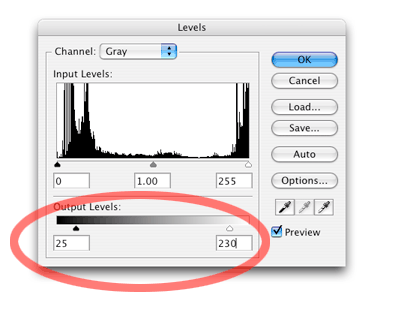
Real-World Example - preparing grayscale photos for a book published by Triumph Books

This publisher, Triumph Books, required author/photographer Pete Souza to tone his grayscale pictures to certain dot percentages as required by the printing press on which the book was to be printed. By their request, it appears that their operation isn't fully color-managed, and that more traditional ways were in place.
Photoshop doesn't think in terms of dot "percentages", but instead, uses a more finely divided "Levels" scale, usually with 256 steps of gray.
Background - Printing press dot limitations
A printing press can't reproduce the extreme shadow or extreme highlight range of
a photograph well. In the brightest highlights, very small dots disappear leaving an
obvious "hole" in the reproduction. In the darkest shadows, large dots tend to
merge together, muddying any detail that may be present. Most pressmen prefer to have a
printing plate that does not have any solid black areas (100% dot) and does not have very
small dots in the highlights. After you tone a picture on screen to your satisfaction, you
may limit the dot percentage range in the Output Levels part of the Levels dialog box as
seen below. The chart shown below the diagram lists typical Photoshop Levels data to use
for this adjustment.

| Printing Stock | Dot Percentage Range | Photoshop Output Levels |
| Newsprint | 12-88 | 30-225 |
| Uncoated Stock | 10-90 | 25-230 |
| Coated Stock | 5-95 | 12-243 |
*Data from the book Real World Scanning and Halftones by David Blatner and Steve Roth, Peachpit Press.
TIP: To convert from printer's dot percent numbers to Photoshop levels, use this formula:
Photoshop level = 255 - (2.55 x percent)
As you might imagine, different paper stock reacts differently to dot limitations. Because newsprint is the most absorbent paper stock, dot gain and other printing problems are more pronounced when it is used. Coated papers have the least dot gain and can hold much smaller dots in the highlights without problems. The table above gives typical values for the dot percentages that various paper stock can hold. These percentages have been calculated. These values may vary depending upon halftone screen frequency, type of ink, and a host of other factors, so view this data as a starting point.
Note that some modern printing facilities may automatically compensate for dot gain (and more) with a color management system that knows the press' limitations. At many larger newspapers and magazines, this adjustment is often done automatically in the production cycle by the pre-press department. However, not all printing companies have color management systems in place, and the designer or photographer may have to individually adjust pictures to suite a particular printing press - like the Obama book pictured above. When in doubt, ask the printing company if they are color managed to account for dot gain, and other printing considerations. If not, it may fall upon you to employ measures like that given above to ensure the best reproduction quality.
The effects of this adjustment are cumulative! Don't adjust this value more than once, or the reproduction will deteriorate rapidly. The numbers given above are useful if you are working as a freelance designer, and you are the person responsible for production quality of the illustrations.
This adjustment compresses all tones to fit in the range specified, and does not limit the range by the method of "clipping" the highlight or shadow tones. The adjustment will shift all tones in the file, which you can determine through an on-screen experiment using a gray step scale (sometimes called a step wedge in the trade). Steps for the creation of a digital step wedge are detailed at https://www.afterness.com/digital/step_scale.html